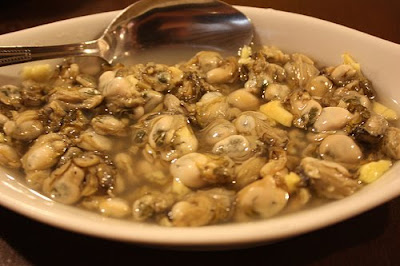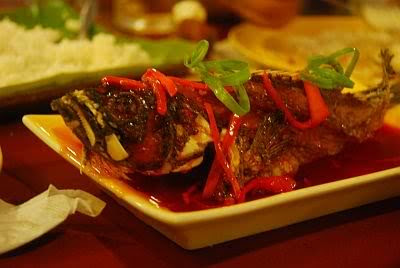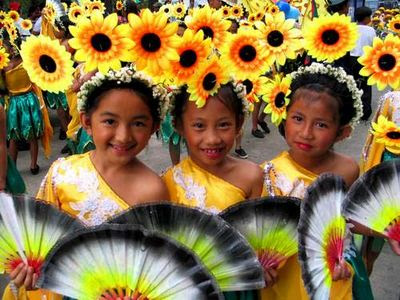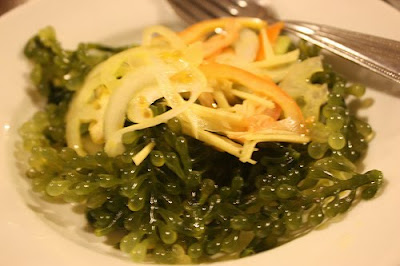Tacloban City Guide
Your Ultimate Travel Guide To Tacloban, Your Window To The Pacific
Welcome To Tacloban City Guide
Welcome to Tacloban City, the place to be. Discover the beauty of Tacloban through its many faces. Situated in a city by the bay, this bustling new metropolitan has a rich cultural and religious heritage dating back to the Spanish times. It is the commercial capital of Leyte, and spans the connecting route between the North and Southern Philippines. Wine and dine, play and have fun, enjoy and relive. This is Tacloban, home to the Pintados and Sangyaw.
Wednesday, August 31, 2011
Saturday, June 4, 2011
Cool Mobile Phone Screensaver
Win Vista Wallpaper
Friday, June 3, 2011
Ocho Seafood And Grill




If you’re looking for the best Sutukil restaurant with a flair, then Ocho Seafood and Grill would be the best choice. Located along Salazar street, this restaurant comes with a classy style, comfy interior design, nice lighting and of course sumptuous food. It’s basically what people come here for. They started out way back in early 2000 with a single floor and has now expanded to occupy the second floor with a wider ground space area in order to cater to a bigger crowd. They also have a privacy area reserved for functions and special meetings.
Ocho specializes in seafood dishes and you can choose from the best selection of live fresh fishes or seafood catch straight out from the sea in their small market section. The good thing is: everything is fresh. You can see a display of oysters, maya-maya, tuna belly, lapu-lapu, matambukid, sea shells and many more. After properly weighing your find, have it cooked the Ocho way or as the locals have it “paluto”. There’s also a nice selection of desserts if you have the craving for sweets. I have my favorites though that is a must try and also among their best sellers in their list.
History Of Sangyaw: A Taclobanon’s Heritage






Sangyaw is a popular native festival held every 29th of June in Tacloban city. Sangyaw, which means “to announce or herald a news” in the local dialect, has assumed a popular following after its creation by then former First Lady Imelda Marcos in 1976. The current festivities became an annual event until 1986 when the late Corazon Aquino assumed the presidency and abolished Sangyaw. It was only in 2008 when Mayor Alfred Romualdez, a nephew of the former first lady, finally revived the Sangyaw festival and was readily accepted with by the reinvigorated Taclobanon community in the city and other parts of the region.
Sangyaw is religious in origin and traces its roots to a purely Taclobanon Christian beginning. Sangyaw Festival showcases the rich cultural and religious heritage of the natives of Tacloban and the province it belongs to. Warriors painted in colorful costumes, women performing elaborate rituals and the incorporation of Christianity are just some of the events featured in the event. The main attraction, however, is the devotion to the Sto. Niño, patron of Tacloban City. Local city contingents consisting of representatives from the different city schools and barangays will usually have a woman carrying the Sto. Niño statue who’ll dance in a trance, symbolic of the native Catholic ritual thanking the Sto. Niño for the blessings and luck it has brought to this lovely bayside city in Eastern Visayas. Historically, the Sangyaw is based on popular belief that the statue of Sto. Nino miraculously survived a shipwreck around 1880's. This was after the original icon, brought by the Spaniards in 1888, have to be brought back to Manila for reconstruction and refitting. On its way back to Tacloban, the steamer "Luzon" which was its carrier caught in a disastrous fire and sank. The alcalde or mayor of Tacloban that time, Hermano Mayor Arcadio Zialcita, felt the grief and sadness of the loss of a patron. Sometime in May of 1889, however, a letter from Military Governor Jose Gil de Avalle of Mindoro received by the Governor of Leyte to the effect that the Barrio Lieutenant of Barrio Semirara in Mindoro sighted a box labelled “Santo Niño, Patron han Tacloban.” Immediately volunteers were dispatched and finally recovered he image to reach the shores of Tacloban in June 30, 1889. The "salubong" or meeting place when the image was received with much celebration is around present-day Balyuan tower, near the Sto. Nino parish.
The Sto. Nino church in Tacloban has thousands of devotees all throughout the year. It is said that an intercession prayer to the Sto. Nino reaps miracles. Many such wonder miracles have been attributed to the Sto. Nino by the locals such as healing, good health, wealth, family, and guidance.
Today, the Sangyaw Festival is a cocelebration of that popular belief by adjoining with other localities from all over the Philippines to showcase their rich cultural heritage thru dances and religious pageantry. Many contingents join in hoping to bring home the bragging rights for the Php500,000.00 prize and a trophy, Second prize of Php300,000.00 and trophy and a third prize of Php200,000.00 and a trophy. Other prizes are for Best in Street Dancing, Best In Choreography, Best In Music, Best In Costume and Best In School and Community Showcase.
Mayor Alfred Romualdez and his wife, City First Councilor Cristina Gonzales-Romualdez, has been actively promoting the Sangyaw festival. Within a year of the festival’s revival, it has gained significant attention in the tourism industry and international recognition of a festival deeply rooted in Taclobanon tradition. Senator Juan Ponce Enrile is a staunch advocate who urged Department of Tourism (DOT) to promote the Sangyaw Festival of Tacloban City in overseas market to bring more tourists to the city in particular and the country in general. “The Sangyaw Festival is so impressive that it could be in the list of must-see attractions in the country”, he was quoted as saying.
Tacloban City Prepares For Fabulous Five 2011
Tacloban city is now abuzz with the upcoming Tacloban city fiesta and the Sangyaw celebrations. One awaited event is the yearly selection for the Fabulous Five, a counterpart of Ms. Tacloban. It was announced that this year’s top 15 contenders out of the 39 auditioning males will vest for the first prize, second and third prize and two other runner-ups for various cash prizes, trophy and the recognition to carry the name as Tacloban’s Finest Gentlemen. Tacloban City Astrodome has been eyed as the venue for the event with guest celebrity host Karyll. Current title holder, Reynaldo Dayola, is expected to relinquish the crown who has only words of praise to say for the position which he held since winning number one in 2010’s search for Fabulous Five. “This has made me wholesome, gained me confidence which I thought I never have had before” he said. This project of Tacloban City First Councilor Cristina Gonzales-Romualdez was an immediate success. She is totally supported by the beloved city mayor Hon. Alfred Romualdez, who made it a point that this activity aims to promote the talents and potential of the young male Taclobanon.
The 15 contestants will be judged in the following categories: manly and handsome appearance- 30% and communication ability -30%, physical and personality – 30%
Prior to the main event, they will be strutting their stuff in wearing Tacloban’s finest designer showcase in Barong Tagalog come the first week of June at Robinson’s Place Activity Center.
2010 Tacloban’s Fabulous Five winners were: Edward Joseph Go, Nathaniel Canas, Paul Michael Ortega, Reynald Dayola and Harvey Isaga.
Thursday, June 2, 2011
Sto. Niño Church











Sto. Niño Church of Tacloban City draws its awesome grandeur from the history of its people and the icon of the Child Jesus who’ve made it a permanent home. A bastion of Catholicism in this city of 220,000, Sto. Niño church safeguards the evangelical faith of approximately 70% of Taclobanons who are Catholics. Headed by a monsignor, he’d be assisted by five or seven other clerics who help him manage the busy schedule of the parish. I used to serve the parish priest here when I was still a seminarian. The parish church is usually very busy during Lent and from Advent to Christmas. Significant church events are also held here.
Going back through time, the original church structure was built by the Jesuits as a small chapel or ‘visita’ under the titular Dulce Nombre de Jesus. They found the location a practical site for the new converts since it faces a wide channel and is situated on solid plain ground. The small chapel was made up of light materials and nipa. The Jesuits would visit the ‘Iglesia Katoliko’ by way of a vanca, from a nearby port known as Balyuan. This happened around 1596 and came under the guidance of the Palo friary. When the Jesuits where expelled from the country, the Augustininans from nearby Cebu Basilica del Sto. Niño took over and renamed the chapel Sto. Niño in 1768, the same year when Tacloban was declared ac city and the first Spanish settlers settled in. The Franciscans came in around 1843 to manage the parish and by 1860, a new Romanesque Church in was built with a towering appearance and the prominence of round arches and small windows ventilating around the church. The church was made of adobe and a mixture of coral stones, a common style and method during this period. Two belfries were attached on top. Unfortunately, a strong typhoon blew the uppermost part of the roof and caved in, paving way for the church to be rebuilt with only one belfry. During wartime, an earthquake damaged the church and a new more modern style was built with the aid of semi-modern construction materials. It was only in 1990 that the church was finally handed over to the Archdiocese of Palo. The present form of the church dates back to 1986 with a new repainting job in early 2000. The new altar was inaugurated during the Jubilee year on April 15, 2000. Several noted priests became the parish priest of Sto. Nino including the now bishop Rev. Monsignor Filomeno Bactol, Msgr. Cesar Petilla, and Msgr. Abarca.






















